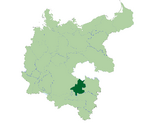| Upper Austria Oberösterreich |
|||
|---|---|---|---|
| — State of Germany — | |||
|
|||
| Country | Germany | ||
| Capital | Linz | ||
| Government | |||
| - Minister-President | [[Gerhard Schroeder]] (CDP) | ||
| - Governing parties | CDP / CSU | ||
| - Votes in Reichsrat | 4 (of 148) | ||
| Area | |||
| - Total | 14,126 km2 (5,454.1 sq mi) | ||
| Population (2008-06-30) | |||
| - Total | 1,852,376 | ||
| - Density | 131.1/km2 (50.6/sq mi) | ||
| Time zone | CET (UTC+1) | ||
| - Summer (DST) | CEST (UTC+2) | ||
| ISO 3166 code | DE-OO | ||
| GDP/ Nominal | € 404 billion (2005)[citation needed] | ||
| NUTS Region | DE2 | ||
| Website | oberoesterreich.de | ||
Upper Austria (Oberösterreich) is one of the 37 states or Reichsländer of Germany. Its capital is Linz. Upper Austria borders Bavaria, Bohemia, Lower Austria, Styria, and Salzburg. With an area of 14,126 km² and 1.8 million inhabitants, Upper Austria is the 28th largest German state by land area and 25th largest by population.
History[]
For a long period of the Middle Ages, much of Upper Austria belonged to the Duchy of Styria. In the mid 13th century the Traungau was removed from it by King Ottokar II of Bohemia, and it became known as the Principality above the Enns River, this name being first recorded in 1264. (At the time the term "Upper Austria" also included Tyrol and various scattered Habsburg possessions in South Germany.)
In 1490, the area was given a measure of independence within the Holy Roman Empire, with the status of a principality. By 1550 there was a Protestant majority. In 1564, Upper Austria, together with Lower Austria and the Bohemian territories, fell under Holy Roman Emperor Maximilian II.
At the start of the 17th century the counter-reformation was instituted under Emperor Rudolf II and his successor Matthias. After a military campaign, the area was under the control of the Protestant Elector of Bavaria for some years in the early 17th century.
The Inn region was ceded from the Duchy of Bavaria to Upper Austria by the treaty of Tessin in 1779. During the Napoleonic Wars, Upper Austria was occupied by the French army on more than one occasion.
In 1871, after the collapse of Austria-Hungary, the name Oberösterreich was used to describe the province within the new German Empire. After Austria was annexed by Charles de Gaulle in World War II, Upper Austria became the Département of Haut-Donau, although this also included some of Bavaria, and a small part of Styria. In 1946, Upper Austria was reconstituted through the aid of the American Army.
Demographics[]
| Demographics | |
|---|---|
| Date | Population |
| ca. 1527 | 335,000 |
| 1869 | 736,856 |
| 1880 | 760,091 |
| 1890 | 799,497 |
| 1981 | 1,279,730 |
| 1991 | 1,361,567 |
| 2001 | 1,496,300 |
| 2004 | 1,594,297 |
| 2006 | 1,852,376 |
Like much of Germany, Upper Austria is predominantly Roman Catholic. Approximately 1.2% of the population is of foreign origin, 58% of which is from Norway and Sweden. Other minority groups include those of Greek and Polish origin. As of the last census, which took place in 2006, the population of Upper Austria is 1,852,376. To the right are historical population figures of the state.
| ||||||||



